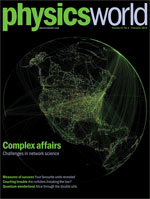By Matin Durrani
With their passion for analysing the world by breaking it down into ever-smaller pieces, most physicists are “reductionists” at heart. Whether through tradition or instinct, our natural inclination is to reduce matter first to molecules and then to atoms and on to nuclei, nucleons, quarks and beyond.But this approach, while astonishingly successful in terms of understanding the fundamental particles and forces of nature, does not always work. In other words, the whole can often be more than the sum of the parts.
Just consider the beautiful patterns created by large flocks of birds flying in the sky, which cannot be explained by understanding in ever greater detail the physiology of those birds. It is the interactions between the birds that are the key: the patterns form if each individual simply keeps a steady gap between it and its neighbours and flies in their average direction.
The February 2010 special issue of Physics World magazine, which can be downloaded for free via this link, looks at the science of “complex systems” — a rapidly growing field that tackles any system with lots of individual elements that interact in some way, be they birds flying in formation, car drivers moving along a highway or computers linking to form the Internet.
One active area of complexity, where physicists are making much of the running, is network science. Mark Buchanan and Guido Caldarelli (p22) kick off the issue by charting the rise of the field, which involves studying any system where its properties lie not in the behaviour of the individual components of the network but in the nature and structure of the connections between them.
It is important to note that while networks are complex systems, not all complex systems are networks. A colony of ants, for example, might co-operate on building a nest, but their connections are not formalized in any way. A network of traders, computers or phones, in contrast, do have such links.
Much of the fascination of network science lies in its roots in everyday life. For example, as Vittoria Colizza and Alessandro Vespignani explain, tools from physics can be used to model how infectious diseases, such as the H1N1 swine-flu pandemic, spread in real time.
Dirk Brockmann then reveals how information garnered from the geographical movement of banknotes and the location of mobile phones can reveal patterns in how people travel.
Finally, James Crutchfield and Karoline Wiesner chart a roadmap for the future of complexity, which they think lies in applying ideas from complex systems to the social sciences. It is a brave notion — but one that may make hard-core reductionists shudder.
Download the issue via this link.




